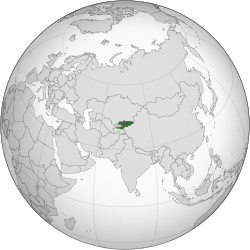
Back Кырӷызсҭан Abkhazian Kyrgyzstan ACE Кыргызстан ADY Kirgisië Afrikaans Kirgisistan ALS Кыргызстан ALT ኪርጊዝስታን Amharic Kurgyzstan AMI Kirguizistán AN Cirgisstan ANG
Kyrgyz Republic | |
|---|---|
| Anthem: Кыргыз Республикасынын Мамлекеттик Гимни "National Anthem of the Kyrgyz Republic" | |
 Location of Kyrgyzstan (green) | |
| Capital and largest city | Bishkek 42°52′N 74°36′E / 42.867°N 74.600°E |
| Major languages | Kyrgyz & Russian |
| Minority languages |
|
| Ethnic groups (2019[2]) | |
| Religion |
|
| Demonym(s) | Kyrgyz |
| Government | Unitary presidential constitutional republic |
| Sadyr Japarov | |
| Akylbek Japarov | |
| Talant Mamytov[3] | |
| Legislature | Supreme Council |
| Independence | |
| 840 | |
| 27 November 1917 | |
| 5 December 1936 | |
| 31 August 1991 | |
| 21 December 1991 | |
| 26 December 1991 | |
| 2 March 1992 | |
| Area | |
• Total | 199,951 km2 (77,202 sq mi) (85th) |
• Water (%) | 3.6 |
| Population | |
• 2020 estimate | |
• 2009 census | 5,362,800 |
• Density | 27.4/km2 (71.0/sq mi) (176th) |
| GDP (PPP) | 2019 estimate |
• Total | |
• Per capita | |
| GDP (nominal) | 2019 estimate |
• Total | |
• Per capita | |
| Gini (2018) | low |
| HDI (2019) | medium · 120th |
| Currency | Kyrgyzstani som (c) (KGS) |
| Time zone | UTC+6 (KGT) |
| Driving side | right |
| Calling code | +996 |
| ISO 3166 code | KG |
| Internet TLD | .kg |
Kyrgyzstan, officially the Kyrgyz Republic, is a country in Central Asia. The country is landlocked (has no coast) and mountainous. It has borders with China, Kazakhstan, Tajikistan, and Uzbekistan. Its capital is Bishkek. It was a socialist republic of the Soviet Union, but became independent in 1991. The country was peaceful in the 1990s. Its president, Askar Akayev showed an autocratic and authoritarian character.
Russian is spoken as an official language at state level.
In 2005, there was an unexpected revolution after the elections of parliament (the legislature) in March. President Akayev resigned on April 4 of that year. Opposition leaders formed a coalition (a group from more than one party), and a new government was formed, led by President Kurmanbek Bakiyev and Prime Minister Feliks Kulov.
At the moment, different political groups are fighting for power in the republic. Three of the 75 elected members of Parliament have been murdered. Kyrgyzstan’s main religion is Islam.
- ↑ 1.0 1.1 "Основные итоги естественного движения населения январе-августе 2020г". stat.kg.
- ↑ 5.01.00.03 Национальный состав населения. [5.01.00.03 Total population by nationality]. Bureau of Statistics of Kyrgyzstan (in Russian, Kyrgyz, and English). 2019. Archived from the original (XLS) on 2018-11-13. Retrieved 2021-08-27.
- ↑ "Сейчас Kg🇰🇬".
- ↑ "History of Central Asia". Encyclopædia Britannica. Retrieved 12 March 2021.
- ↑ 5.0 5.1 5.2 5.3 "Kyrgyz Republic". data.worldbank.org. World Bank. Retrieved 14 December 2019.
- ↑ "GINI index (World Bank estimate) - Kyrgyz Republic". data.worldbank.org. World Bank. Retrieved 22 March 2020.
- ↑ Human Development Report 2020 The Next Frontier: Human Development and the Anthropocene (PDF). United Nations Development Programme. 15 December 2020. pp. 343–346. ISBN 978-92-1-126442-5. Retrieved 16 December 2020.

